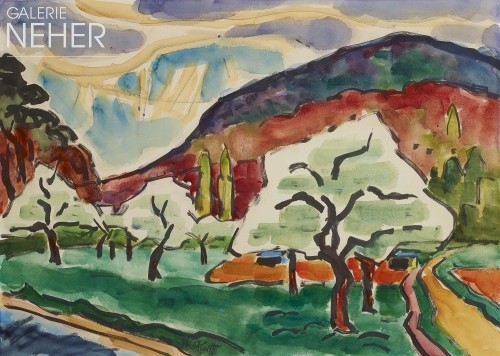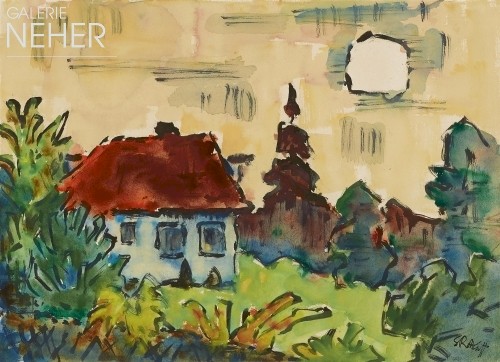Karl Schmidt-Rottluff
* 01 12 1884 | Chemnitz
† 09 08 1976 | Berlin
Karl Schmidt-Rottluff became famous as a member of the Brücke (Bridge) artist group. He is among the most important artists of Expressionism. Oil paintings, watercolours, drawings, woodcut prints and impressive sculptural works characterise his both extensive and varied oeuvre.
Works by Karl Schmidt-Rottluff
Vita Karl Schmidt-Rottluff
1884
Born on 1 December in Rottluff near Chemnitz as Karl Friedrich Schmidt. Attended the Humanistisches Gymnasium in Chemnitz.
1902
Friendship with Erich Heckel, who he met in the Vulkan literary school club.
1905
Study of architecture at the Königlich-Sächsische Technische Hochschule (Royal Saxon Technical College) in Dresden. Met Ernst Ludwig Kirchner and Fritz Bleyl.Founded the artist cooperative Brücke together with his fellow students on 7 June. Karl Schmitt added his place of birth to his name and subsequently called himself Karl Schmidt-Rottluff.
First woodcut prints.First Brücke exhibition in the art dealership P.H. Beyer und Sohn in Leipzig. He saw paintings by Vincent van Gogh in the Ernst Arnold gallery in Dresden.
1906
Max Pechstein and Emil Nolde joined the Brücke. A four-month stay with Emil Nolde and his wife in the summer on the Baltic Sea island of Alsen.
1906/07
Took a furlough from his studies and dedicated himself exclusively to visual arts. First lithographs.
1907
Schmidt-Rottluff discontinued his studies permanently. In Hamburg, acquaintance with the art historian Rosa Schapire, who championed his work. The attorney and collector Gustav Schiefler purchased lithographs of the artist.
1907–12
Regular summer stays in the Dangast moor and in Dangast on the Jade Bight, sometimes accompanied by the colleagues Erich Heckel and Max Pechstein.
1910
He maintained a small studio in Hamburg. First solo exhibition in Galerie Commeter in Hamburg in the spring. Major Brücke exhibition in Galerie Arnold in Dresden. Became a member of the New Secession in Berlin and of the Deutscher Künstlerbund (Association of German Artists).
1911
Several week stay on the Hardanger Fjord in Norway at the invitation of the Hamburg collector Bertha Rohlsen.
Move to Berlin in October. His painting became more abstract. Friendship with Lyonel Feininger.
1912
Participation in the Sonderbund exhibition in Cologne. The cubist works of Pablo Picasso deeply impressed him.
Last stay in Dangast on the North Sea from mid-May to mid-August.
1913
Brücke artist community dissolved. Summer stay in Nidden on the Curonian Spit. He began collecting non-European tribal art.
1914
Stay of several weeks in Hohwacht on the Baltic coast of Holstein.
1915 –18
Military service in Lithuania and Russia; initially directly to the front, before he was redeployed to the press office of the High Command.
1919
Marriage to the photographer Emy Frisch. Friendships with the sculptors Georg Kolbe, Richard Scheibe, Emy Roeder and the architect Walter Gropius.
1920
A first monograph by Wilhelm Reinhold Valentiner was published by Klinkhardt & Biermann.
1920–31
Regular summer stays in Jershöft on the Baltic coast of Eastern Pomerania.
1921
Outfitted the apartment of the art historian Rosa Schapire in Hamburg with furniture and works of art.
1923
Travelled with Georg Kolbe and Richard Scheibe to Italy.
1924
Publishing of the catalogue raisonné of the prints by Rosa Schapire.
Schmidt-Rottluff travelled to Paris and Dalmatia.
1927–29
Several stays in Ticino.
1930
Scholarship from the Villa Massimo in Rome.
1931
Schmidt-Rottluff became a member of the Prussian Academy of Arts.
1932–43
Regular summer stays in Rumbke at the Lebasee in Hinterpommern.
1933
Left the Prussian Academy of Arts. His works in German museums were confiscated.
1936
First exhibition in New York in the Westermann Gallery.
1937
His works were shown in the Entartete Kunst (Degenerate Art) exhibition, others were burned.
1941
Painting prohibition. Expulsion from the Reich Chamber of Fine Arts.
1943–46
The couple lived at Schmitt-Rottluff’s parents’ home in Rottluff after studio and apartment were destroyed by bombing.
Honorary citizen of the City of Chemnitz.
1946–59
Professor at the Hochschule für Bildende Künste in Berlin, taught from 1947 to 1954.
Regular summer stays in Sierksdorf on the Bay of Lübeck until 1973.
After 1948
Regular exhibitions in the Frankfurt Kunstkabinett of Hanna Bekker vom Rath.
1949–53
Annual autumn stays in Ticino.
1952
Kunstpreis der Stadt Berlin (Art Prize of the City of Berlin).
1954
Major exhibitions in Berlin, Hamburg, Kiel and Nuremberg on the occasion of his 70th birthday.
1956
A comprehensive monograph with a catalogue raisonné of the oil paintings by Will Grohmann was published.
Awarded the Pour le Mérite for Sciences and Arts.
1958
Großer Kunstpreis des Landes Nordrhein-Westfalen (Grand Art Prize of the Federal State of North Rhine-Westphalia).
1961
Kunstpreis der Stadt München (Art Prize of the City of Munich).
1963/64
Major exhibitions in Hannover, Essen, Frankfurt and Berlin on the occasion of his 80th birthday.
The oeuvre catalogue of the graphic work by Ernst Rathenau was published. The last paintings produced.
1967
Opening of the Brücke-Museum in Berlin at his initiative.
1970
Honorary citizen of Berlin. Last watercolours produced.
1970/71
Last pencil crayon and ink and brush drawings.
1974
Exhibitions in Hamburg, Berlin, Frankfurt and Stuttgart on the occasion of his 90th birthday. Honorary member of the American Academy of Arts and Letters in New York.
1975
Emy Schmidt-Rottluff died on 30 September.
1976
The artist died on 10 August in Berlin.
About Karl Schmidt-Rottluff
Beginnings
Karl Schmidt already developed an interest in painting and literature as a schoolboy and received well-rounded instruction in the elective subject of art at the Königliches Gymnasium. He became familiar with works of Naturalism, Impressionism and Pointillism from visiting exhibitions in the Chemnitz Kunstverein Kunsthütte (art association). He painted his first landscape watercolours directly from nature, followed after 1902 by autodidactic attempts at oil painting.
Brücke in Dresden
In June 1905, the architecture students Karl Schmidt-Rottluff, Erich Heckel, Ernst Ludwig Kirchner and Fritz Bleyl founded the Brücke artist group and formulated their programmatic claim to a “direct” and “authentic” art. Schmidt-Rottluff’s painting radicalised under the influence of a Van Gogh exhibition: a brilliant, expressive palette of pure colours, as well as pastose, rough and unconnectedly placed brush strokes or agitated lines that dissolve form now characterised his paintings and watercolours. Numerous woodcut prints also already originated in the early Brücke years; landscapes and portraits were his preferred motifs.
Dangast
Regular stays on the German coast defined Schmidt-Rottluff’s work rhythm and his painting throughout his life. In Dangast in around 1910, he developed his characteristic flat style with highly diluted oil paint in brilliantly coloured, summary landscape compositions. The still life now complemented his work as another subject.
Berlin
Although his experience of the big city was not reflected in his work in terms of motifs, Schmidt-Rottluff’s conception of painting transformed with the move to Berlin: Cubist and Futurist stylistic devices found their way into his work, broke up the areas and resulted in a new contention with volume. His involvement with non-European tribal art from Africa and Oceania found its way into his still lifes in the form of masks, pipe bowls or bowls.
Nudes
The nude motif never attained the significance in the work of Karl Schmitt-Rottluff that it did for the other Brücke artists. Initial works in interiors originated in 1912, nudes in the landscape in 1913 during a stay in Nidden on the Curonian Spit: powerful bodies in fiery flesh tones and abbreviated reduction merged with the surrounding nature. The representation of figures also dominated in the painting and woodcuts of the following years, often with a melancholy, introverted expression. Inspiration from African sculptures was increasingly evident in the mask-like conception of faces.
First World War
His military service in Lithuania and Russia left little room for artistic work, but Schmitt-Rottluff occasionally carved printing blocks in found wood during this time and the first completely sculptural works in a primitivist language of form in 1916/17. Still during this time, he began to work on his impressive series of woodcut prints of the life of Christ in 1918.
The 1920s
After the war, Schmidt-Rottluff resumed painting in oil and watercolour. Fascinated by the simple life in the small Baltic Sea village of Jershöft, he produced paintings of fishermen, farmers and craftsmen conducting their daily work. The generously dimensioned area forms of his paintings were usually outlined with a black contour. Against the background of New Objectivity and his acquaintance with the sculptors Georg Kolbe and Richard Scheibe, a change in style could be observed as of the mid-1920s: in landscapes, still lifes, portraits and nudes, the painting achieved a subtle palette, the pictorial space was more sculpturally designed. During a stay at Villa Massimo in Rome in 1930, he almost exclusively painted architectural motifs.
Years of defamation
The period of National Socialist rule was defined for Schmidt-Rottluff by defamation, confiscation, destruction of his works, as well as by exhibition and ultimately vocational prohibitions. The painter only rarely resided in Berlin, instead retiring to Hofheim in the Taunus Valley, where the collector Hanna Bekker vom Rath provided him with refuge, or to the small, lonely fishing village of Rumbke on Lake Leba in Eastern Pomerania. The human being disappeared from his work. The quiet, often melancholy landscape representations adopted a symbolic character and became, like the group of mask works, a mirror of his inner state. The retreat to the immediate living space became tangible in the interior.
Fresh start after 1945
Schmidt-Rottluff returned to Berlin in 1946 after being offered a professorship. Here he forged a link to his existing work in still lifes, landscapes and self-portraits with bold, opulent colouring and an extreme reduction in form and remained loyal to the stylistic means of Expressionism. The coloured line acquired a pictorial life of its own as a decorative or ornamental element and set the area in motion.
The late work
At the age of 80, Schmidt-Rottluff quit painting in oil on canvas and concentrated in his last decade exclusively on watercolours, as well as on ink and pencil crayon drawings. The expressive colourfulness of his previous work now made way for a more delicate, translucent and transcendent tone, which increasingly dematerialised the pictorial subjects.

